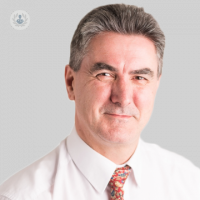How are muscle spasm pains in temporomandibular disorders best managed?
Written by:Muscle spasm pains, also known as myofascial pain, caused by temporomandibular disorders can be felt along the side of the face, the jaw or the cheekbone and can even extend to the area behind the ear. In this detailed guide, revered consultant oral and maxillofacial surgeon Professor Andrew Sidebottom sheds lights on the advantages and disadvantages of various modalities used to treat myofascial pain and expertly explains which factors can lead to a worsening of symptoms.

What is myofascial pain?
Muscle spasm (myofascial pain) is a common component of temporomandibular disorders (TMD) and is often confused for joint pain leading to unnecessary and unhelpful surgical intervention.
Muscle spasm pains tend to be poorly defined in their location and occur either below the ear along the angle of the jaw, or up into the temple. Occasionally the pain can feel as though it is in or behind the ear, or spread down into the neck or across towards the eye socket along the cheek bone. Patients with masticatory myofascial pain (pain in the muscles used to chew) often also have pain in the neck muscles, shoulder girdle and back, in which case they will be described as having myofascial pain syndrome. This can also be related to conditions such as fibromyalgia.
Night-time jaw clenching (bruxism) or postural habits such as nail biting and clenching of the teeth contribute to this issue. Stress may also make it worse and the patient may develop clicking of the jaw joint secondary to the clenching.
How is myofascial pain managed?
Management of myofascial pain is non-surgical and indeed surgical intervention may make it worse. Initial management requires an accurate assessment and diagnosis carried out by a doctor who specialises in assessing this type of issue.
Areas of muscle spasm may be felt as tight bands in the muscle which are tender to examination. There may be restriction of mouth opening or even locking, where the jaw opens to a certain amount then has to be “wiggled” to open further. The teeth may not feel as though they meet in the right place and the pain may be worse in the mornings.
Initially, masticatory myofascial pain is managed with rest, muscle massage and a bite splint worn at night to help to relax the muscles overnight. The areas of muscle spasm should be firmly massaged for one minute, four times a day. Chewy food should be avoided and if a prolonged dental visit is needed, the patient should try to rest their mouth for a minute every ten to fifteen minutes to help reduce the risk of a flare of the spasm.
When these methods fail to fully resolve symptoms then three other additional management techniques should be considered, with the above continuing to support these.
Physiotherapy
This should preferably be provided by a specialist physiotherapist trained in the management of TMD. Many of these are registered on the ACPTMD website of specialist physiotherapists. They will often consider a very holistic approach to management including mindfulness techniques as well as muscle stretching, strengthening and acupuncture.
Muscle relaxant medication
Traditionally, medications such as Amitriptylene and Nortriptylene have been proved effective in cases of myofascial pain. Many years ago, these were used as anti-depressants in much higher doses (150-300mg). On weaning patients off these medications, it was discovered that lower doses had an anti-anxiety effect and even lower doses relaxed muscles.
The usual therapeutic dose for myofascial pain is between 30mg and 50mg, however only around seventy per cent of patients can manage to get to this dose as they may experience side effects such as morning drowsiness, stomach upset and vivid dreams. It is best to start at 10mg on a night when you don’t have to be up early and work out whether to take them earlier in the evening if they do cause some sedation. This form of mediation will take you into a deeper plane of sleep where clenching is less likely to occur.
You will need to discuss with your GP whether these are appropriate in your individual case according to any other medical problems you suffer from, other medicines you take or your lifestyle. These effects diminish over a few weeks, but unfortunately the beneficial effects of relieving the pain can take two to three weeks to commence. For this reason the dose should be increased slowly in 10mg steps every month until pain is relieved or side-effects prevent an increase. The maximal dose tried should be 50mg. If beneficial, the pain relieving dose should be continued for six months then weaning off should be attempted, with resumption for a further three months if the pain returns. Treatment can be supervised by your GP, a pain physician or suitably trained clinician.
Alternatives such as Gabapentin and Pregabalin have been suggested but have recently been considered inappropriate by NICE.
Botulinum injections
Botulinum injections are particularly useful when only one or two muscles are involved and should probably not be considered when there is a generalised myofascial syndrome.
Treatments for myofascial pains are often continued for several months then weaned off, but may need to be recommenced at a later date as some individuals are more prone to recurrence than the general population. These pains tend to become worse at times of stress as the stress response will increase muscle tension.
I hope this article helps to guide in your choice of management but I am more than happy to carry out a remote or face to face consultation if you require diagnosis or support and advice with ongoing treatment.
If you are suffering from painful spasms associated with temporomandibular disorders and would like to schedule an appointment with Professor Sidebottom to discuss your treatment options, you can do so by visiting his Top Doctors profile


